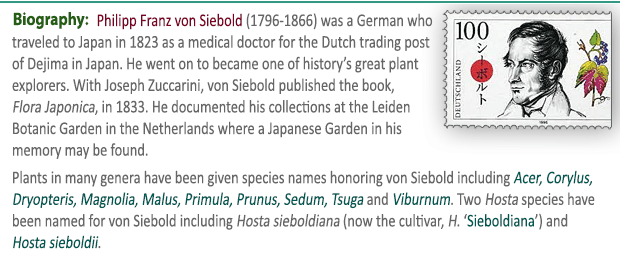|
   In 1988 Peter Ruh of Ohio registered this
cultivar of unidentified parentage (thought to have
H. sieboldii
in its background) on behalf of the originator,
David Stone of Connecticut. It grows
to a small size hosta
about 9 inches high with a spread of 24 inches. The leaves are lanceolate, slightly wavy and it bears pure white flowers in August. In 1988 Peter Ruh of Ohio registered this
cultivar of unidentified parentage (thought to have
H. sieboldii
in its background) on behalf of the originator,
David Stone of Connecticut. It grows
to a small size hosta
about 9 inches high with a spread of 24 inches. The leaves are lanceolate, slightly wavy and it bears pure white flowers in August.
According to
The Hostapedia by Mark Zilis (2009), "...has always been a favorite of
mine for its combination of white-margined foliage and white
flowers in late summer. It can be used as a ground cover or
edging plant."
 The Book of Little Hostas by Kathy and Michael Shadrack
(2010) says: "Takes quite a lot of sun and can be used as an
edging plant in a woodland garden or in a raised
bed. Flowers match margin for whiteness." The Book of Little Hostas by Kathy and Michael Shadrack
(2010) says: "Takes quite a lot of sun and can be used as an
edging plant in a woodland garden or in a raised
bed. Flowers match margin for whiteness."
The New Encyclopedia of Hostas by
Diana
Grenfell (2009) states: "Site in some morning sun in cooler climates to
boost the rather poor vigor. Slow to increase but worth the wait
since there are so few white-margined hostas with white
flowers...The blade is set obliquely on the petiole. The white
flowers have green tips.
An article titled
The Hosta Legacy of the Late David Stone
appeared in the 1985 issue of what was then called
The American Hosta Society Bulletin. The article was
authored by Stone's former partners in the Piedmont
Gardens nursery in Waterbury, Connecticut,
F. Henry Payne and
Philip R. Payne. "We named H. 'Carrie
Ann' in 1979... Reaching only four to five inches in
height, it remains fully miniature, with dense growth.
Its leaves are 4 1/2 to 5 inches long, about 3/4 inch in
width, and are a uniform medium green center with a very
neat 1/4 inch margin of creamy white. The flower stem is
10 inches tall with white flowers, which are pendant. It
seems to be a vigorous plant." This is one of the
so-called
David Stone's Miniatures.


In
The
Hosta Journal (1992 Vol. 23 No. 1) there is an article by Peter
Ruh about the so-called David Stone Medium or Miniature hostas which went by
a numbering system that started with
DSM. This cultivar was
called DSM #6 and was described as "Medium, spreading
plant, grey-green leaves, narrow white edge, flowers white,
named by
Payne."




 |



